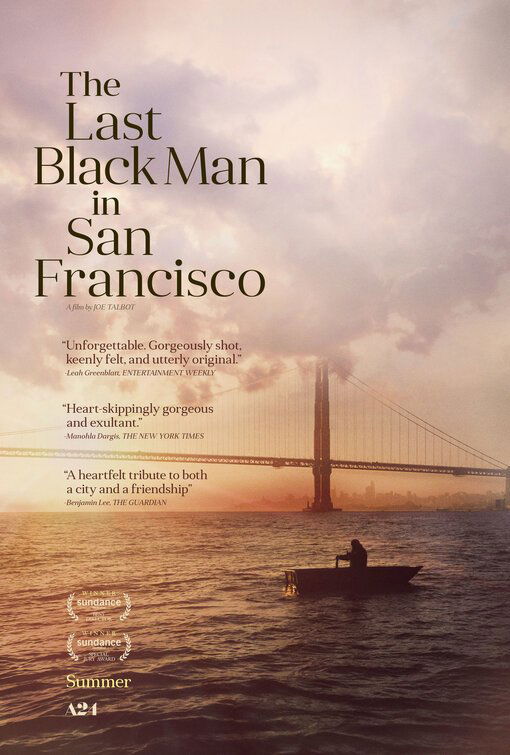"A Mesmerizing Visual Poem"

| None | Light | Moderate | Heavy | |
|---|---|---|---|---|
| Language | ||||
| Violence | ||||
| Sex | ||||
| Nudity |
What You Need To Know:
THE LAST BLACK MAN IN SAN FRANCISCO is a mesmerizing visual mood piece that grabs viewers from the start. Director Joe Talbot kicks things off with an awe-inspiring opening sequence where Jimmie and Monty hop on the same skateboard and soar through the streets of San Francisco on their way to work. The movie uses similar tricks to create a unique look and feel. However, it also has a Romantic worldview with lots of foul language and a couple scenes of male nudity intended to bring some laughs. So, the movie is excessive.
Content:
More Detail:
It’s no secret that San Francisco is beset with all manner of troubles these days, from rampant homelessness to terribly unsanitary conditions in much of its prime locations. Yet, its huge hills and beautiful historic architecture still hold a magical allure for millions, and a young actor-writer named Jimmie Fails makes a dramatic stand for its preservation in the stunning new drama THE LAST BLACK MAN IN SAN FRANCISCO.
Fails has come out of seemingly nowhere with the movie, in which he plays a fictional version of himself in a story co-written by his best friend, Joe Talbot, who directs the movie. The story follows the fictional Jimmie and his best friend, Monty (Jonathan Majors), as Jimmie tries desperate and inventive measures to reclaim his childhood home after 12 years when its owners are forced to leave the premises.
Jimmie has had the deck stacked against him his entire life, with a mother who abandoned him years ago and a father who is a former junkie who subsists by making and selling pirated DVDs in a dingy hotel room. Monty is stuck working in a fish shop while dreaming of becoming a playwright. He spends much of his time outside of work listening to the conversations and arguments of the people he sees on the streets around him.
Jimmie discovers that the older white couple who took over the house when his family fell apart are being evicted due to a family property dispute. So, he and Monty break and start squatting in there. Jimmie has always been told his grandfather built the fantastical house and even manages to reclaim his grandfather’s assortment of odd furniture and other possessions to fill the building’s massive empty space.
On the one hand, this brings Jimmie great happiness. On the other hand, it also creates a slow-building tension as he and Monty struggle to remain unnoticed and wonder when the other shoe is going to drop.
THE LAST BLACK MAN IN SAN FRANCISCO doesn’t rely much on conventional narrative, but rather is a mesmerizing visual poem and mood piece that grabs viewers from the start and never lets go. Director Joe Talbot kicks things off with an awe-inspiring opening sequence where Jimmie and Monty hop on the same skateboard and soar through the streets of San Francisco on their way to work. As they zip through the streets and soar up and down its incredible hills, numerous images of the people they pass are freeze-framed or slow-motioned as they stare at the two young friends flying by. This visual trick and many others are employed by Talbot throughout the movie, creating a unique look from start to finish that recalls and even surpasses the dazzling cinematography of Spike Lee’s early work.
With Emile Mosseri’s stirring musical score that combines orchestral power with a jazzy undertone, LAST BLACK MAN becomes a feast for the senses. It’s regrettable, however, that it includes lots of foul language from a chorus of aimless young black men who often comment on what Jimmie and Monty do. There are also a couple brief, humorously intended scenes of excessive male nudity. THE LAST BLACK MAN IN SAN FRANCISCO has a strong Romantic worldview. The lead character, Jimmie, lives by the personal fantasies he’s built up over the years. Regrettably, the movie is excessive.



 - Content:
- Content: 